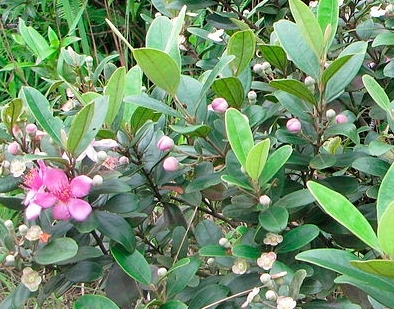

Researchers have discovered that the rose myrtle of Southeast Asia is one of the greatest sources of a phenolic compound more active than the resveratrol found in the skin of grapes (photo: Earth100 / Wikipedia)
Researchers have discovered that the rose myrtle of Southeast Asia is one of the greatest sources of a phenolic compound more active than the resveratrol found in the skin of grapes.
Researchers have discovered that the rose myrtle of Southeast Asia is one of the greatest sources of a phenolic compound more active than the resveratrol found in the skin of grapes.

Researchers have discovered that the rose myrtle of Southeast Asia is one of the greatest sources of a phenolic compound more active than the resveratrol found in the skin of grapes (photo: Earth100 / Wikipedia)
By Elton Alisson, in Brussels (Belgium) | Agência FAPESP – The success enjoyed by açaí (Euterpe oleracea) obtained in Brazil and in various parts of the world in recent years is due to contributions made by Yvan Larondelle, a professor in the Faculty of Bioscience Engineering at the Catholic University of Louvain (UCL).
The researcher was one of the first to study the Amazon fruit and reveal that it is extremely rich in antioxidant phenolic compounds – substances such as the polyphenols, found in red wine, that have beneficial effects on cardiovascular diseases.
“One 250 ml glass of açaí extract has 1 g of phenolic compounds,” Larondelle remarked in a talk given at FAPESP Week Belgium, held in the cities of Brussels, Liège and Leuven October 8-10, 2018.
Larondelle has devoted the past 25 years to discovering and exploiting the potential of little-known fruits and vegetables that may be neglected sources of bioactive compounds – substances that naturally occur in food and positively interfere in metabolism but are not nutritionally necessary.
In order to reveal new sources of bioactive compounds, the strategy used by Larondelle and his team has been to select promising plant material based on its consumption and utilization in traditional medicine.
If a food meets these requirements, the next step for researchers is to conduct chemical characterization of potential bioactives and evaluate the bioactivity of the compounds in vitro and in vivo to determine whether they have such things as antioxidant, anti-inflammatory, anti-atherosclerotic, anti-obesity or anti-cancer properties.
Once those properties have been determined, partnerships are established with companies for the purpose of developing products such as foodstuffs, food supplements or food additives using those fruits, like in the case of açaí, Larondelle explained.
“The accumulated knowledge on açaí has been transferred to local communities in Brazil and has led to improvement of the microbiological quality of the fruit pulp, and optimization of the harvest period and production processes,” he said.
After the açaí, another fruit that recently aroused his interest is the rose myrtle (Rhodomyrtus tomentosa (Ait.) Hassk) of Southeast Asia.
Used in folk medicine to treat diarrhea and boost the immune system, the fruit is one of the plant kingdom’s greatest sources of piceatannol – a phenolic compound more active than resveratrol, which is found primarily in the skin of grapes, in terms of antioxidant, anti-inflammatory, anti-proliferative and anti-lipogenic properties.
“Piceatannol appears to interfere with lipid accumulation in adipose tissue,” Larondelle stated.
Using the study, the researchers have helped growers of the fruit used in Vietnam to produce juice and alcoholic beverages to correct defects in production and develop processes to extract piceatannol more efficiently. The goal is to introduce the bioactive compound as a way of adding value to other food commodities.
Republish
The Agency FAPESP licenses news via Creative Commons (CC-BY-NC-ND) so that they can be republished free of charge and in a simple way by other digital or printed vehicles. Agência FAPESP must be credited as the source of the content being republished and the name of the reporter (if any) must be attributed. Using the HMTL button below allows compliance with these rules, detailed in Digital Republishing Policy FAPESP.





